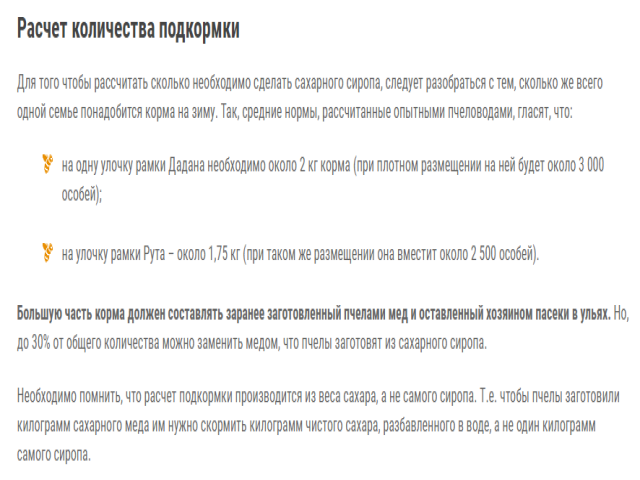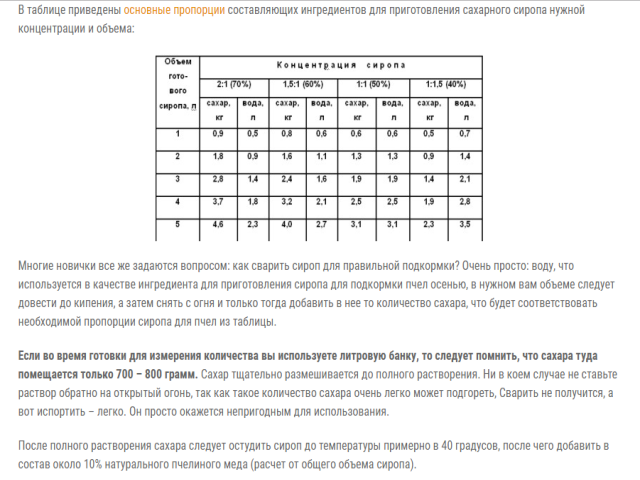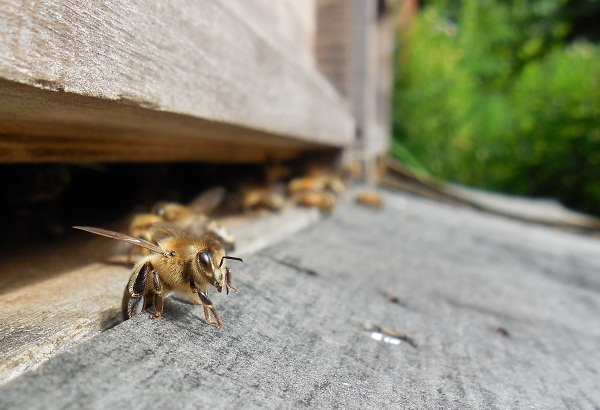 In order for the bee family to winter well, it is necessary that there is a sufficient supply of honey in sealed honeycombs. All beekeepers are inclined to believe that the best option for wintering bees is the feed that they prepared on their own. But there are a number of reasons when autumn feeding of bees with sugar syrup is necessary.
In order for the bee family to winter well, it is necessary that there is a sufficient supply of honey in sealed honeycombs. All beekeepers are inclined to believe that the best option for wintering bees is the feed that they prepared on their own. But there are a number of reasons when autumn feeding of bees with sugar syrup is necessary.
Content
Why and in what cases do you need autumn top dressing?
It should be noted right away that top dressing with syrup is carried out only for a strong healthy family. This is due to the fact that the bees spend a lot of energy on its processing into honey, that is, they wear out. Therefore, only insects from brood overwinter. Weakened individuals may not withstand such a load. To improve such families, beekeepers connect weak and strong families.
When top dressing is needed:
- if there were not enough bribes and the bees were unable to procure the right amount of honey for the winter.
- to restore the stock of natural product after pumping;
- if for some reason the honey harvested in the winter began to be sugared;
- not all cells are sealed;
- honeydew honeycomb prevails. It is obtained from the sweet juice secreted by some insects, for example, caterpillars. Or sweet plant juice (honey dew). It is harmful, it is so poorly processed by insects and makes them thirsty;
- useful additives, medicines are added to the composition.
The timing of the autumn feeding of bees with sugar syrup depends on the region, but usually no later than 10 September.
In fact, preparation for winter begins after the last honey harvest. In August, they make the last pumping out of honey, from this moment you can start feeding. If the process is delayed for the month of September, this will lead to negative consequences. Brood bees will begin to process syrup and will not survive until spring. Excess feed can serve as a signal for the uterus to be red.
Due to the onset of cold weather, young individuals will not be able to fly around, so they will begin to clear themselves in the evidence. Feces, diarrhea, framed - this is a threat of insect disease, in particular nematosis. The insect does not eat honey from honeycombs in which there is a bowel movement.
During this period, after the last pumping, measures are taken to clean up evidence from ticks, and preventive measures to combat diseases. Experienced beekeepers pay attention to the fact that drugs that are added to the feed do not need to be zealous, since they are poorly digested by insects in the winter, can also lead to diarrhea.
Read also:
What types of syrups are there and their methods of preparation
Recipes for autumn feeding of bees with sugar syrup are varied. Like every gardener, beekeepers have their own approaches, additives, distribution methods.

Much depends on the region of beekeeping, on which evidence in the winter road or on the street overwinter. There are three types of top dressing, syrup:
- Sugar. But here, every beekeeper selects his own recipe.
- Inverted. Its difference is that it is better absorbed by the digestive system of the bee. The composition is supplemented with natural honey. The insect wears out less. Since sucrose, after a while turns into glucose, fructose.
- Honey is full. A mixture of natural bee honey and water.
Important! For a good wintering and a strong family, you need not only honey (carbohydrates), but also protein. The best protein food is pollen (pollen). Therefore, a small amount should be present in the evidence.
You can feed insects only in the evening, when they have finished circling.
Sugar syrup
When consuming sugar syrup, take into account how much honey the bees can get from it. It is wrong to draw a parallel between the amount of nutrient solution and the final result, processed honey. Only the quantities of sugar consumed must be considered. On average, a kilogram of natural product is obtained from a kilogram of sugar. A quarter of the composition is spent by bees on its processing and transportation to the combs.
Ultimately, for the family to winter well, it is necessary that in one cell there should be from 2 to 3 kg of honey.
What sugar and water is better to use:
- For cooking, only fine white sugar of good quality is suitable, without any additives and impurities. Water should be soft, better from springs, wells, or purified.
- It has already been mentioned that each beekeeper in the recipe makes its own adjustments. Practice shows that the optimal is 60-64% composition. Some beekeepers prefer 70% top dressing.
- Syrup is diluted with water brought to a boil, but not with boiling water. Insects are fed a slightly warmed composition (about 40 degrees).
| Syrup | Sugar | Water | Additives |
| 60 %
70 % |
1,5 kg
2 kg |
1 liter
1 liter |
Optional: pine syrup, fir oil, silver water etc. |
Optional: pine syrup, fir oil, silver water etc.
Feeding methods are also different:
- Using feeders mounted on top of the evidence. To do this, slightly unscrew the canvas to form a gap, and put the feeder. They are sold ready-made, most of the beekeepers independently make them.
- You can pour the syrup into several frames.
- Set inside the house.
Autumn bee dressing with sugar syrup in bags is also popular. For these purposes, make, as in the case of feeders, a small gap in the canvas. The syrup is poured into dense plastic bags, mainly 30 * 40 and placed on top of the canvas. You can make several small punctures with a thin needle. But the bees themselves will be able to pierce the package if they have found top dressing.
If the bees winter in Omshanik, and not on the street, then they need less food for the winter. It also depends on the number of frames left for the winter. The best option when in one clue 8-9 frames and in each from 2 to 3 kg of honey.
Inverted syrup
Inverted top dressing, in which sucrose breaks down and is easily absorbed by bees, is prepared with the addition of honey. There is a syrup formulation without honey, with food acids. The main goal of sugar conversion. Controversial among beekeepers remains acid supplementation.
Video:
What is the advantage of this type of top dressing:
- insects spend less energy on assimilation, and, therefore, do not wear out so;
- it is noted that they are more tenacious and active in the spring;
- positive effect on weakened families;
- it is not subject to crystallization.
It is more expensive than sugar syrup, but cheaper than natural honey. A kind of middle ground.
Cooking recipes
1 way (without honey)
Structure: water (6 l), sugar (7 kg), citric acid (12-14 g).
Cooking: everything is mixed and heated and boiled, then infused for several hours.
2 way
To 70% sugar syrup add 10% percent of honey. Bring water to a boil and add sugar, then add honey. Knead well and insist for a week, during which time the process of sugar breakdown will take place.
3 way (using special preparations)
Now you can quickly invert the usual syrup, using additives, for example, Bee.Water and sugar are taken in equal proportions, then, according to the instructions, the drug is added. Fermentation lasts an average of 2 days, at a temperature of 20 to 45 degrees.
Honey is full
 This is top dressing with honey diluted with water in different concentrations. The most expensive, but the most useful way. Moreover, you can use old stocks of natural bee products.
This is top dressing with honey diluted with water in different concentrations. The most expensive, but the most useful way. Moreover, you can use old stocks of natural bee products.
It is noted that this method helps to increase the number of insects in the family, increases resistance to various diseases. The concentration is selected depending on the purpose of feeding.
For August-September feeding use thick satiety. To do this, add one portion of water to three portions of honey. Thickened honey is pre-heated, but not on fire, but in a water bath. The water is boiled and cooled, the ingredients are mixed at 40 degrees.
An important point! Do not use cast-iron cookware for the preparation of solutions. Suitable food aluminum, plastic, enameled containers.
Medicinal supplements
Often in the autumn feeding of bees add food additives and medicines. So coniferous concentrates serve as an additional source of vitamins and protein, and also adversely affect the tick. Juniper helps to overcome various infections.


A tincture of several cloves of garlic helps with many diseases, including varroatosis.
Tincture with bitter pepper kills ticks, but is completely harmless to bees, moreover, they even like it. Infusion (45-50 grams of pepper per liter of boiling water in a thermos) is mixed with a liter of syrup. Just tincture, using a spray, process the frame. Sometimes hot peppers are mixed with tincture of wormwood.
Tincture of hawthorn fruits added to syrup enhances insect immunity. For these purposes, it is better to chop the fruit.
 You can use finished products, for example, CAS-81. It is also mixed with top dressing. This is an extract from pine needles.
You can use finished products, for example, CAS-81. It is also mixed with top dressing. This is an extract from pine needles.
Summing up, it should be noted that the autumn feeding of bees with sugar syrup on time is extremely important for the wintering, preservation and health of the bee family. The appearance and composition of each beekeeper determines individually. Inverted syrup is better absorbed and full. But you need to ensure that in addition to stocks of honey, protein food is additionally present.
This is a great way to heal insects and fight many diseases. For these purposes, it is preferable to use natural additives. If all preventive measures are carried out on time and efficiently, then in the next season strong bees will bring a lot of honey.



 Bee pork: beneficial properties and how to take
Bee pork: beneficial properties and how to take